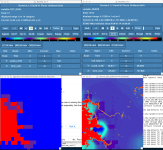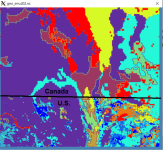Hyejin Lim
New member
Hi!
I have some problem with SMOIS.
I just used ERA5 data for meteorological input, and wrf.exe worked just well, but variable SMOIS in wrf_out file appears little bit weird.
I think this is affected by different ISLTYP, but when I changed the data to fnl data with same condition, this problem doesn't appear even though this fnl data uses the same ISLTYP!
[initial stage]

[7 hours later]

[ISLTYP]

horizontal resolution is 1 km, and that 1 patch size is about 5 X 5 km.
that patch slowly disappear when time passes about 20 days to 1 month..
What should I change?
I have some problem with SMOIS.
I just used ERA5 data for meteorological input, and wrf.exe worked just well, but variable SMOIS in wrf_out file appears little bit weird.
I think this is affected by different ISLTYP, but when I changed the data to fnl data with same condition, this problem doesn't appear even though this fnl data uses the same ISLTYP!
[initial stage]

[7 hours later]

[ISLTYP]

horizontal resolution is 1 km, and that 1 patch size is about 5 X 5 km.
that patch slowly disappear when time passes about 20 days to 1 month..
What should I change?


